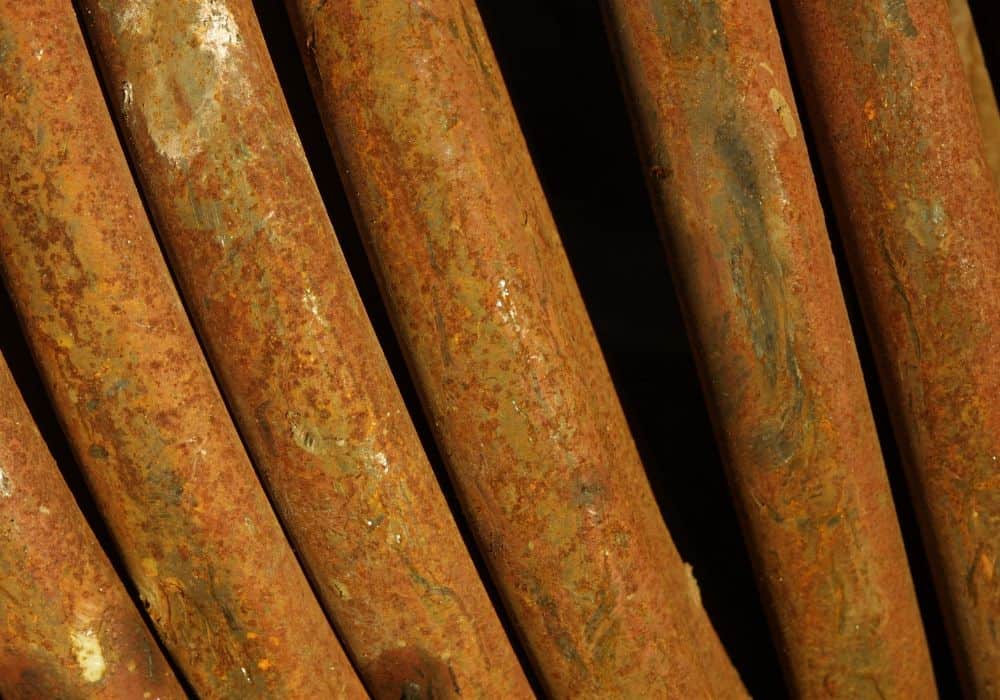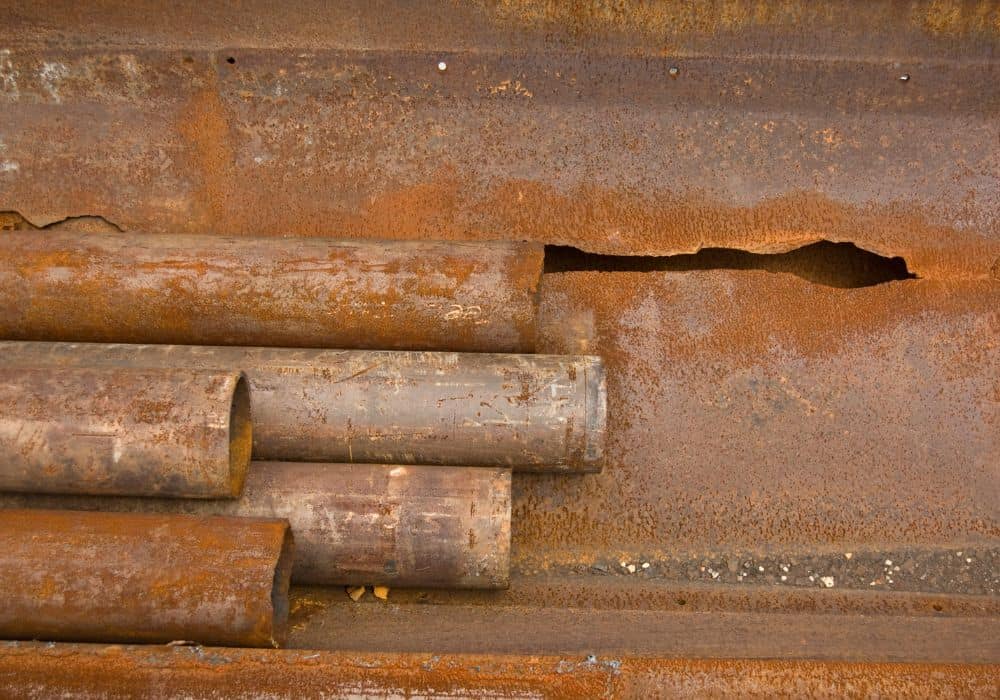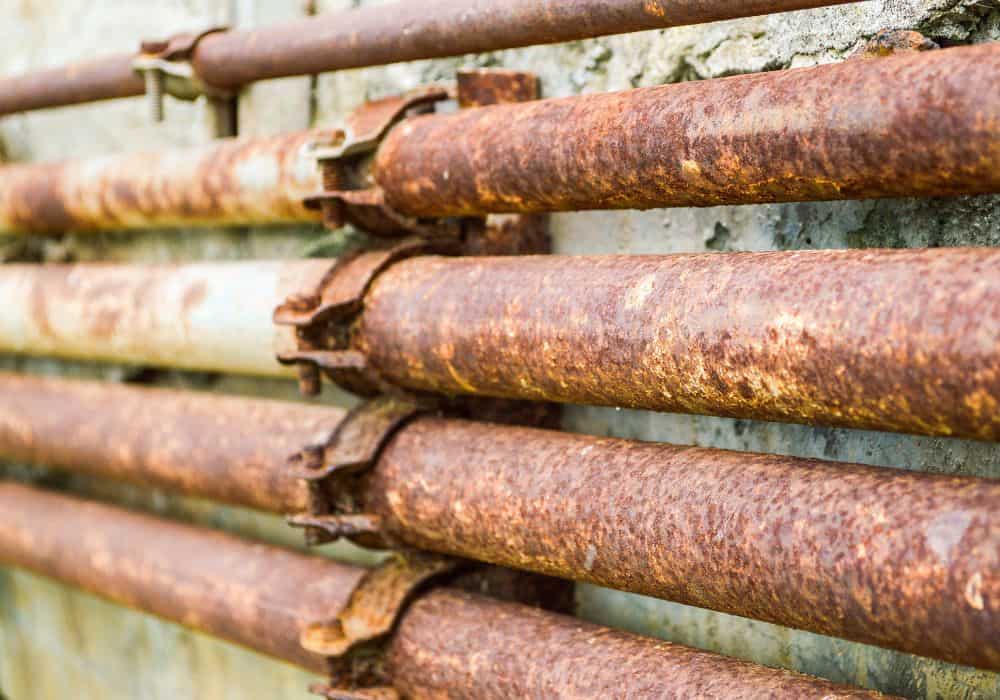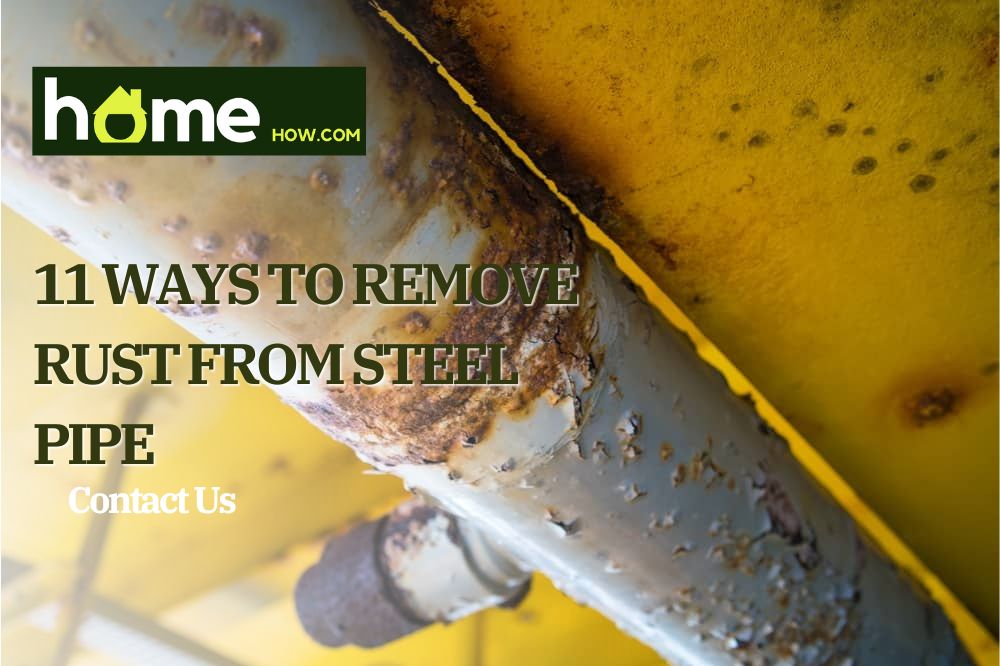Are you bothered by the rust stains on your steel pipe? Well, you should be, for this oxidation can make your once-durable pipe brittle and prone to leaks.
If you don’t know how to go about this, then you need not worry. Here’s a comprehensive guide on how to remove rust from steel pipe with the use of household or industrial agents.
Let’s start!
Tools Needed
- Baking Soda Method: damp rag, baking soda, steel wool brush
- Vinegar Method: white vinegar, bucket, rags, water, steel brushes
- Lemon and Salt Method: salt, lemon, water, cloth
- Coca-Cola Method: Coca-cola, bucket, steel brush
- Potato and Dish Soap Method: potato, dish soap
- Citric Acid Method: citric acid, hot water, bowl, steel brush, cloth
- Oxalic Acid Method: oxalic acid, gloves, protective eyewear
- WD-40 Method: WD-40, wire brush, dishcloth
- Naval Jelly Method: wire brush, fine-grit sandpaper, cloth or paper towel, rubber gloves, respirator, sponge, naval jelly, water or moistened rag, bucket
- Evapo-Rust Method: bucket, Evapo-rust, steel brush, water
- Whink Rust Stain Remover Method: Whink solution, water, or damp rag
How to Remove Rust from a Steel Pipe’s Surface
There are many ways to remove rust from your pipes. In fact, some methods make use of products you’ll find in your cabinet, as you’ll see below.
But before you go about with any of them, the first thing you need to do is turn off your water supply first. Once this crucial step is done, you may proceed with any of the methods below.
1. Baking Soda Method
Baking soda is not just for baking. As a mild alkali, it can help dissolve rust – thus making it easier to remove.
Here’s how to use baking soda on a mildly-rusted pipe:
- Clean the pipe with a damp rag.
- Dust the rusty areas with baking soda. Leave it on for an hour.
- Scour the pipe with a steel wool brush until you remove all the rust. Do note that this step will require some elbow grease!
- Clean the pipes with water (or a damp rag) and towel-dry.
Pro tip: Another option is to mix baking soda with water. This will form a paste that you can easily apply on rusty areas.
2. Vinegar Method
White vinegar is another cabinet staple that you can use for significant rust removal. Being acidic, it can easily remove corrosion – granted you follow the steps below.
- Remove the rusty pipe and submerge it in a vat of vinegar. Leave overnight.
- Get the pipe from the vat and remove the rusty patches with a steel wool brush.
Pro tip: If you can’t remove the pipe from the system, you can use a spray bottle to apply vinegar on the rust areas. You can also soak rags in vinegar and place them around the galvanized pipes.

3. Lemon and Salt Method
Lemon (or lime) juice is an acidic solvent that can help remove rust from the pipe. Salt particles, on the other hand, act as gentle abrasives that don’t damage the steel surface.
Here’s how to use these ingredients to remove small (and not-so-stubborn) pipe rust:
- Sprinkle salt on the affected area.
- Squeeze lemon juice (or lime juice) on the salted metal pipe.
- Let the juices sit for 30 minutes. For more severe rusting, you may want to leave the lemon and salt on the pipe for 1-2 hours (or until the rust disappears completely.)
- Rub the rust away with the lemon/lime rind. No need to use a steel brush!
- Rinse the pipe and pat dry with a cloth.
4. Coca-Cola Method
Coca-cola is not just for quenching your thirst. It can also help remove rust, thanks to its phosphoric acid content. This material interacts with iron oxide, which then obliterates the corrosion on cast iron pipes.
Here’s how to remove rust with Coca-Cola:
- Uninstall the rusty pipe from your plumbing system.
- Fill a bucket with Coca-cola. Put your pipe in and make sure that your pipe is completely submerged. Leave it overnight.
- Scrub the rust flakes off.
- Rinse the pipe and dry it off.
Pro tip: If you can’t remove your rusty pipe and submerge it, you can scrub the affected areas with a cola-soaked sponge or aluminum foil.
5. Potato and Dish Soap Method
Although these two materials don’t seem like much, they can help remove small rust stains.
The process of using these two simple items is as follows:
- Slice a potato in half. Pour dish soap on the open end.
- Use the potato like you would a steel brush. You’ll be surprised at how the potato and soap interact (and remove) the rust stains.

6. Citric Acid
Just like vinegar, citric acid can remove the rust by eating away at the corroded areas. While you may not find citric acid in your cupboard, you can readily buy it from your neighborhood store.
Here’s how to strip off pipe rust with citric acid:
- Remove the portion of rusty seamless steel pipe.
- Submerge the pipe in a mixture of 2-3 tablespoons of citric acid and hot water.
- Leave the pipe in the citric acid solution overnight.
- Take the pipe off the solution and remove the remaining rust with a steel wool brush.
- Rinse the pipe and pat dry.
Pro tip: Citric acid can remove paint and old coatings. Unless you’re okay with this happening, then you may want to try another method on this list.
7. Oxalic Acid Method
Oxalic acid is a chemical cleaning material that can easily remove stubborn rust. For this method, you need to:
- Uninstall the rusty pipe.
- Wear safety goggles and rubber gloves.
- Mix 1 gallon of water and 3 tablespoons of oxalic acid in a bucket.
- Immerse the pipe in the oxalic acid solution for 20 minutes.
- Rinse the hardware with water and dry it accordingly.
8. WD-40 Method
WD-40 is one of the more popular lubricants in the market. But did you know that it can be used to remove steel pipe rust as well?
In fact, here’s how you can use WD-40 to clean your corroded pipes:
- Spray WD-40 on the affected area. Leave it on for 10-15 minutes.
- Scrub the rusty area with a wire brush.
- Wipe clean with a cloth.
9. Naval Jelly Method
Naval jelly is a product made of water and acids that help dissolve rust. Here’s how to use it on your steel pipes:
- Use a wire brush to remove the rust flakes on the steel surface.
- If there are rust flakes remaining, remove them by rubbing sandpaper on the rusty area. Do so in a circular motion for best results.
- Wipe the brushed/sandpapered rust with a cloth.
- Put on your gloves. You should wear your respirator if you are not working in a well-ventilated area.
- Use a sponge to apply naval jelly on the entire pipe. Let the product sit according to the manufacturer’s instructions (usually for 10-15 minutes.)
- Place a bucket under the pipe.
- Pour water over the pipe to help dissolve the rust. You may also use a moist rag to wet hard-to-reach areas.
- Dry the pipe with a cloth or paper towel.
10. Evapo-Rust Method
Many commercial products are solely intended to remove rust. One of these is Evapo-Rust, which is made with water-soluble material.
Here’s how to use Evapo-Rust on your steel pipes:
- Remove the rusty pipe. Clean and remove dirt/oils on the surface, if any.
- Immerse the pipe in the Evapo-Rust solution for 30 minutes.
- Rinse the pipe. If there is remaining rust residue, you may re-soak the pipe again.
- Air-dry the cleaned pipe.
11. Whink Rust Stain Remover Method
As the name suggests, this solution can help remove rust on steel surfaces (pipes included.) It’s just a matter of performing these three easy steps:
- Spray rust remover on the affected areas.
- Let the solution stain until the stains have been obliterated.
- Rinse the pipe with water or clean it with a damp rag.

How to Paint Over Steel Pipes
Although you’ve successfully removed the rust, it doesn’t necessarily mean that corrosion won’t hit the pipes again. If you’re not careful, corrosion may produce harmful minerals (such as increased amounts of zinc) that can affect your drinking water supply.
If you want to avoid this completely, then you’ll need to follow these tips on how to paint your steel pipes.
Tools Needed:
- Rust-inhibiting type of coating primer
- Rust-inhibiting metal paint
- Brush (not needed if using an aerosolized version)
- Apply primer on the pipe, even on the rust-free area. Let it dry according to the package instructions.
- Cover the pipe with rust-inhibiting metal paint. Let it dry according to directions as well.
Pro tip: The quality of the coating will help ensure that the pipe won’t rust in the future. So be careful when picking your primer and paint!
Conclusion
Rusty steel pipes can be a costly and hazardous problem. To remove the rust stains on your plumbing system, you may use household materials such as baking soda, vinegar, lemon & salt, and Coca-Cola.
You may also use effective solutions such as Citric Acid or Oxalic Acid.
On the other hand, you may opt for industrial materials such as WD-40, Naval Jelly, Evapo-Rust, or Whink Stain Remover.
I hope this guide has helped you get rid of rusty pipes for good. If you have any questions regarding any of these methods, don’t hesitate to shoot a question below!
